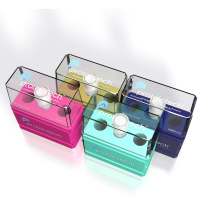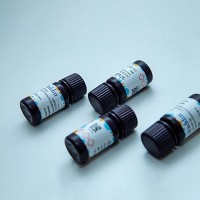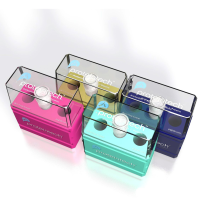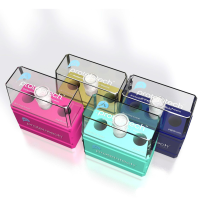Rational Design and Evaluation of FRET Experiments to Measure Protein Proximities in Cells
互联网
- Abstract
- Table of Contents
- Figures
- Literature Cited
Abstract
Fluorescence resonance energy transfer (FRET) refers to the nonradiative transfer of energy from one fluorescent molecule (the donor) to another fluorescent molecule (the acceptor). Measurement of FRET between two fluorophore?labeled proteins can be used to infer the subnanometer spatial and temporal characteristics of protein interactions in their native cellular environment. Multiple experimental methods exist for measuring FRET. The method that can be most widely and simply implemented, quantified, and interpreted is the acceptor?photobleaching FRET technique. In this method, the presence of FRET between a donor and acceptor is revealed upon destruction (by photobleaching) of the acceptor. Acceptor photobleaching can be exploited to detect changes in the composition and organization of subunit proteins within a multiprotein complex and to even gain insight into relative stoichiometries of proteins within the complex. In this unit, strategies, tools, and background for designing and interpreting acceptor?photobleaching FRET experiments in cells are described.
Keywords: Cy3; Cy5; photobleach; stoichiometry; FRET
Table of Contents
- Background Information
- Optimization of Acceptor‐Photobleaching FRET
- Interpretation of Results
- Reciprocal FRET
- Automated Image Analysis
- Conclusion
- Literature Cited
- Figures
- Tables
Materials
Figures
-

Figure 17.9.1 Illustration of the advantage of using antibody probes labeled with multiple dyes. (A ) Cartoon illustrates how each donor dye on an antibody has the potential to transfer energy to four different acceptor dyes on an acceptor antibody. In contrast, a cyan fluorescent protein (CFP) molecule can only potentially transfer energy to one yellow fluorescent protein (YFP) acceptor. The consequence is that multiple dye–labeled acceptor antibodies enhance the probability of detecting FRET. (B ) The relationship of dye number on each donor and acceptor antibody as plotted with simulated data for antibodies bound to antigens that are either assembled in a multiprotein complex (clustered) or distributed in a random manner. See Snapp et al. () for details concerning the simulation parameters. Note that the value calculated for a single dye will not be equivalent to the CFP‐YFP pair because the simulated dye placement on the antibodies was random and could include distances up to three times greater than for the fluorescent fusion proteins. View Image -

Figure 17.9.2 Control for acceptor density dependence. The top left panel is an image of the acceptor‐labeled cell prior to photobleaching. The top right panel shows an energy transfer efficiency map with the extent of energy transfer revealed by acceptor photobleaching in the box. The scale indicated below the map is the energy transfer efficiency (% E ). The plot in the lower left panel displays % E as a function of acceptor‐fluorophore intensity ( I A ). Note that similar FRET values (% E ) are observed over a broad range of acceptor intensities, demonstrating that FRET is not acceptor density dependent for this experiment. View Image -

Figure 17.9.3 Relationship of donor and acceptor concentrations to FRET. (A ) Schematic diagram illustrating the effect of donor concentration on FRET. Oligomers of antigens (black dots) are shown randomly labeled with donor (white) and acceptor (gray) antibodies. The right diagram indicates one half the amount of donor antibody than that in the left panel. Although the donor fluorescence is expected to be lower for the right panel, the proximity of each donor to acceptor antibodies predicts that FRET efficiency should stay the same. The situation is very different for acceptor antibody concentration. (B and C ) Antibody distributions are illustrated for donor (white) and acceptor (gray) antibodies on a hypothetical clustered three‐antigen oligomer (black dots). Panel (B) shows the situation where the donor and acceptor antibodies bind their antigens, but do not interact with each other. Panel (C) shows the situation where the acceptor binds its antigen, but the donor antibody interacts with the acceptor antibody. In both cases, the right panel shows the consequence of reducing the acceptor concentration by one half, and the predicted effect on FRET. View Image -

Figure 17.9.4 Sampling size and the resolving power of antibody‐mediated FRET. (A ) Diagram of a model IgG molecule bound to an antigen on the membrane surface (left). The Fc and each Fab domain are modeled as a cylinder of diameter 30 Å, height 70 Å, connected by flexible hinges. Arrows indicate directions of allowed rotational flexibility. The range of potential positions that can be occupied by dyes conjugated to the antibody surface is indicated on the right. Dyes are allowed to be on the surface of the stalk of the mushroom‐shaped space, and anywhere in the volume of the head. (B ) A simulated donor and acceptor labeled antibody (4 dyes/IgG, randomly distributed as described in panel (A) were bound to antigens separated by distances of between 80 and 160 Å, and the % energy transfer between the dyes calculated and plotted. Each datum represents the average of between 1 and 1000 such simulations as indicated ( n ) on each graph. Custom macros (available upon request from the authors) were written for NIH Image 1.62 to perform the antibody‐mediated FRET simulations. In essence, an algorithm was designed to simulate the stochastic binding of a mixture of donor‐ and acceptor‐labeled antibodies to a set of antigens on a membrane surface, followed by a calculation of the FRET between the randomly distributed dyes on all of the bound antibodies. The algorithm encompassed the following steps: (1) The x ‐ y positions of the appropriate number of antigens were distributed on a hypothetical surface of defined area (usually 0.5 × 0.5 µm) at the indicated density and configuration (either randomly distributed, or in clusters of three). Clusters were not allowed to overlap, and the minimal distance separating adjacent antigens was limited to 8 nm, as determined by the steric hindrance of bound IgG molecules. (2) Each antigen was randomly assigned to either be unoccupied, bound by a donor antibody, or bound by an acceptor antibody. The relative probabilities of each assignment were determined by the desired occupancy and donor/acceptor ratio. (3) The x‐y‐z positions of dyes were randomly chosen relative to each antigen by the criteria outlined in the text. (4) Once the x‐y‐z positions for all of the donor and acceptor dyes were set, the summed FRET efficiency that would be expected for this distribution of dyes was calculated according to previously established equations (Förster, ; Dewey and Hammes, ). View Image -

Figure 17.9.5 Simulations of FRET for assembled versus unassembled oligomers. (A ) Idealized configurations of an oligomeric channel in the membrane in an assembled and disassembled configuration. The positions of a putative antigen present as three copies in the channel are indicated with a black dot. (B ) Surface view of a 70 × 70–nm section of membrane containing antigens (black dots) at 2000 copies per mm2 in assembled and disassembled configurations as in (A). The two dimensional projection of the positions of donor (clear outlined) and acceptor (gray) dyes on antibodies bound to these antigens is also indicated. An antibody was assigned a 20% probability of containing donor dyes. (C ) Monte Carlo simulations were used to calculate the FRET efficiencies in a 0.25 µm2 section of membrane containing donor and acceptor labeled antibodies (at a donor/acceptor ratio of 1:4, each containing 4 dye molecules per IgG) bound to antigens (with 100% occupancy) at densities of 1000 to 5000 copies per µm2 . The antigens were distributed in the membrane surface either randomly (open circles) or assembled into clusters of three (closed circles). The simulation was repeated ten times for each condition, with each point representing the FRET from a single simulation. Note that FRET in the nonclustered configuration displays a clear density‐dependence that is not seen in the clustered configuration. (D ) Monte Carlo simulations of FRET as a function of the degree of occupancy of the antigen by antibody. Randomly distributed antigens (open circles) were compared to clustered antigens (closed circles). Note that % E is always higher for the clustered situation regardless of % occupancy. (E ) Simulation of FRET as a function of the proportion of antibodies that carry donor dyes. Note that the best discrimination between random (open circles) and clustered (closed circles) antigens is seen at donor antibody values below 20%. In (D) and (E), the mean ± SD of ten simulations is plotted for each condition. When not being specifically varied, antibodies contained four dyes each, 20% of antibodies were donors, antigen occupancy was 100%, and antigen density was 2000 copies per µm2 . View Image -

Figure 17.9.6 Simulations of FRET for multiprotein complexes undergoing a conformational change. (A ) Scale diagram of a complex of 90‐ versus 100‐Å diameter. The modeled complex is of three antigens around a circle of the indicated diameter. (B ) Clusters of three antigens in circles of diameters ranging from 9 to 11‐nm were randomly distributed in 0.25 µm2 areas, and the FRET between the bound antibodies calculated by Monte Carlo simulations as in Figure . Each set of 20 measurements was statistically significant from an adjacent set. These findings illustrate that with sufficient sampling even modest changes (in the subnanometer range) to the configuration of a complex can be detected using FRET. View Image -

Figure 17.9.7 FRET‐based analysis of multiprotein complex component interactions and stoichiometry. (A and B ) Cartoon of reciprocal FRET measurements between a hypothetical interacting pair of molecules (squares and circles) at different stoichiometries. The two fields in each panel represent situations in which each shape is labeled as donor (open) or acceptor (gray). The histograms to the right represent relative FRET efficiencies for each situation. Equal numbers of paired squares and circles (A) yields equivalent FRET values regardless of which protein is the donor or acceptor. In contrast, a substoichiometric number of circles, with excess unpaired squares, results in a discordance in FRET between the reciprocal measurements (B). These findings illustrate that by changing the labeling scheme systematically it is theoretically possible to gain insight into the relative stoichiometry between two interacting proteins. View Image -

Figure 17.9.8 Output from the macro developed by the authors to assist in data interpretation (see section). In this experiment, two proteins known to interact were labeled with Cy3‐labeled donor and Cy5‐labeled acceptor antibodies. Shown are the images from a typical FRET measurement. (A ) Image of the donor fluorescence prior to photobleaching of the acceptor. (B ) Image of the donor fluorescence immediately after photobleaching of the acceptor fluorescence in a small square near the center of the image (see panel D). Note that the donor fluorescence has selectively increased in intensity in this region. (C ) Quantitation of the change in donor fluorescence between pre‐bleach and post‐bleach images (i.e., the % E map). The darker gray region near the center of the image indicates an area of significantly increased donor fluorescence relative to the remainder of the image, and reflects a positive FRET signal. (D ) Image of the acceptor fluorescence after photobleaching a square region near the center of the image. View Image
Videos
Literature Cited
| Literature Cited | |
| Adams, S.R., Campbell, R.E., Gross, L.A., Martin, B.R., Walkup, G.K., Yao, Y., and Tsien, R.Y. 2002. New biarsenical ligands and tetracysteine motifs for protein labeling in vitro and in vivo: Synthesis and biological applications. J. Am. Chem. Soc. 124:6063‐6076. | |
| Bastiaens, P.I. and Jovin, T.M. 1996. Microspectroscopic imaging tracks the intracellular processing of a signal transduction protein: Fluorescent‐labeled protein kinase C beta I. Proc. Natl. Acad. Sci. U.S.A. 93:8407‐8412. | |
| Clegg, R.M. 1995. Fluorescence resonance energy transfer. Curr. Opin. Biotechnol. 6:103‐110. | |
| Deniz, A.A., Laurence, T.A., Dahan, M., Chemla, D.S., Schultz, P.G., and Weiss, S. 2001. Ratiometric single‐molecule studies of freely diffusing biomolecules. Annu. Rev. Phys. Chem. 52:233‐253. | |
| Dewey, T.G. and Hammes, G.G. 1980. Calculation on fluorescence resonance energy transfer on surfaces. Biophys. J. 32:1023‐1035. | |
| Förster, T. 1948. Zwischenmolekulare energiewanderung und fluoreszenz. Ann. Phys. 2:57‐75. | |
| Frenkel, D. and Smit, B. 2001. Understanding Molecular Simulations. Academic Press, San Diego. | |
| Haas, E. and Steinberg, I.Z. 1984. Intramolecular dynamics of chain molecules monitored by fluctuations in efficiency of excitation energy transfer. A theoretical study. Biophys. J. 46:429‐437. | |
| Haj, F.G., Verveer, P.J., Squire, A., Neel, B.G., and Bastiaens, P.I. 2002. Imaging sites of receptor dephosphorylation by PTP1B on the surface of the endoplasmic reticulum. Science. 295:1708‐1711. | |
| Huang, C.Y. and Ferrell, J.E. 1996. Ultrasensitivity in the mitogen‐activated protein kinase cascade. Proc. Natl. Acad. Sci. U.S.A. 93:10078‐10083. | |
| Jackson, V. 1999. Formaldehyde cross‐linking for studying nucleosomal dynamics. Methods 17:125‐139. | |
| Jares‐Erijman, E. and Jovin, T.M. 2003. FRET imaging. Nat. Biotechnol. 21:1387‐1395. | |
| Kenworthy, A.K. 2001. Imaging protein‐protein interactions using fluorescence resonance energy transfer microscopy. Methods 24:289‐296. | |
| Kenworthy, A.K. and Edidin, M. 1998. Distribution of a glycosylphosphatidylinositol‐anchored protein at the apical surface of MDCK cells examined at a resolution of <100 Å using imaging fluorescence resonance energy transfer. J. Cell Biol. 142:69‐84. | |
| Krishnan, R.V. Varma, R., and Mayor, S. 2001. Fluorescence methods to probe nanometer‐scale organization of molecules in living cell membranes. J. Fluor. 11:211‐226. | |
| Lippincott‐Schwartz, J., Snapp, E., and Kenworthy, A. 2001. Studying protein dynamics in living cells. Nat. Rev. Mol. Cell Biol. 2:444‐456. | |
| Matyus, L. 1992. Fluorescence resonance energy transfer measurements on cell surfaces. A spectroscopic tool for determining protein interactions. J. Photochem. Photobiol. B. 12:323‐337. | |
| Metz, B., Kersten, G.F.A., Hoogerhout, P., Brugghe, H.F., Timmermans, H.A.M., de Jong, A., Meiring, H., ten Hove, J., Hennink, W.E., Crommelin, D.J.A., and Jiskoot, W. 2004. Identification of formaldehyde‐induced modifications in proteins—reactions with model peptides. J. Biol. Chem. 279:6235‐6243. | |
| Michalet, X., Kapanidis, A.N., Laurence, T., Pinaud, F., Doose, S., Pflughoefft, M., and Weiss, S. 2003. The power and prospects of fluorescence microscopies and spectroscopies. Annu. Rev. Biophys. Biomol. Struct. 32:161‐182. | |
| Miyawaki, A. and Tsien, R.Y. 2000. Monitoring protein conformations and interactions by fluorescence resonance energy transfer between mutants of green fluorescent protein. Methods Enzymol. 327:472‐500. | |
| Miyawaki, A., Llopis, J., Heim, R., McCaffery, J.M., Adams, J.A., Ikura, M., and Tsien, R.Y. 1997. Fluorescent indicators for Ca2+ based on green fluorescent protein and calmodulin. Nature 388:882‐887. | |
| Nichols, B.J. 2003. GM1‐containing lipid rafts are depleted within clathrin‐coated pits. Curr. Biol. 13:686‐690. | |
| Niswender, K.D., Blackman, S.M., Rohde, L., Magnuson, M.A., and Piston, D.W. 1995. Quantitative imaging of green fluorescent protein in cultured cells: Comparison of microscopic techniques, use in fusion proteins and detection limits. J. Microsc. 180:109‐116. | |
| Rizzo, M.A. and Piston, D.W. 2005. High‐contrast imaging of fluorescent protein FRET by fluorescence polarization microscopy. Biophys. J. 88:L14‐L16. | |
| Sharma, P., Varma, R., Sarasij, R.C., Ira, Gousset, K., Krishnamoorthy, G., Rao, M., and Mayor, S. 2004. Nanoscale organization of multiple GPI‐anchored proteins in living cell membranes. Cell. 116:577‐589. | |
| Snapp, E., Hegde, R., Francolini, M., Lombardo, F., Colombo, S., Pedrazzini, E., Borgese, N., and Lippincott‐Schwartz, J. 2003. Formation of stacked cisternae by low affinity protein interactions. J. Cell Biol. 163:257‐269. | |
| Snapp, E., Reinhart, G., Bogert, B., Lippincott‐Schwartz, J., and Hegde, R. 2004. The organization of engaged and quiescent translocons in the endoplasmic reticulum of mammalian cells. J. Cell Biol. 164:997‐1007. | |
| Stryer, L. and Haugland, R.P. 1967. Energy transfer: A spectroscopic ruler. Proc. Natl. Acad. Sci. U.S.A. 58:719‐726. | |
| Van Rheenen, J., Langeslag, M., and Jalink, K. 2004. Correcting confocal acquisition to optimize imaging of fluorescence resonance energy transfer by sensitized emission. Biophys. J. 86:2517‐2529. | |
| Wallrabe, H. and Periasamy, A. 2005. Imaging protein molecules using FRET and FLIM microscopy. Curr. Opin. Biotech. 16:19‐27. | |
| Wouters, F.S., Verveer, P.J., and Bastiaens, P.I. 2001. Imaging biochemistry inside cells. Trends Cell Biol. 11:203‐211. | |
| Zacharias, D.A., Violin, J.D., Newton, A.C., and Tsien, R.Y. 2002. Partitioning of lipid‐modified monomeric GFPs into membrane microdomains of live cells. Science. 296:913‐916. |









